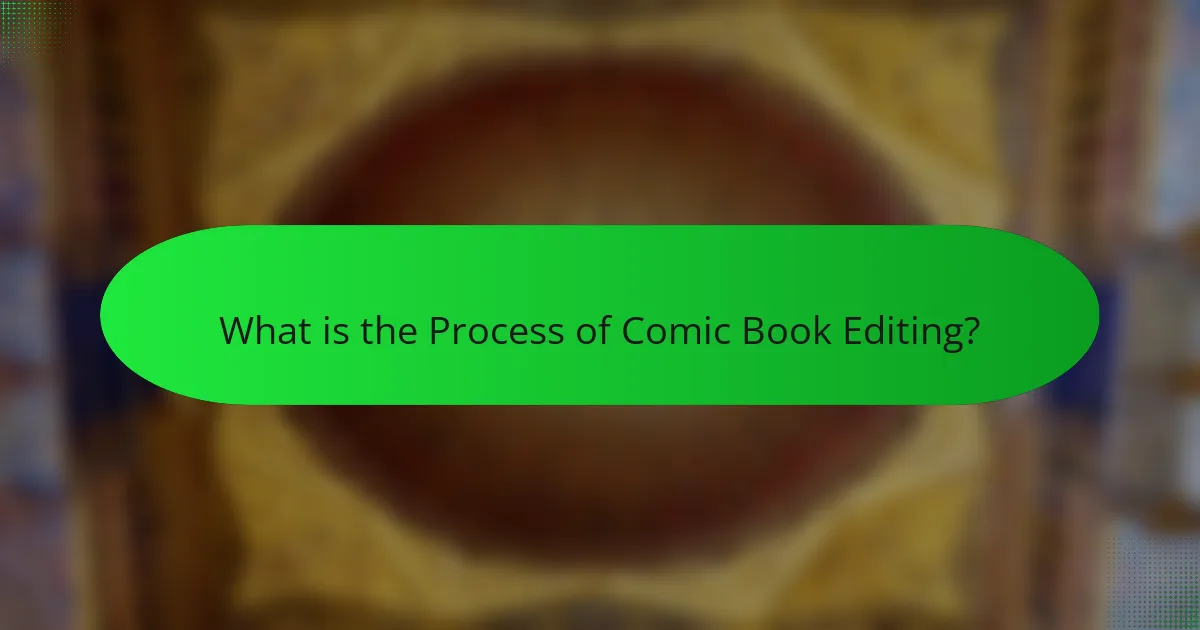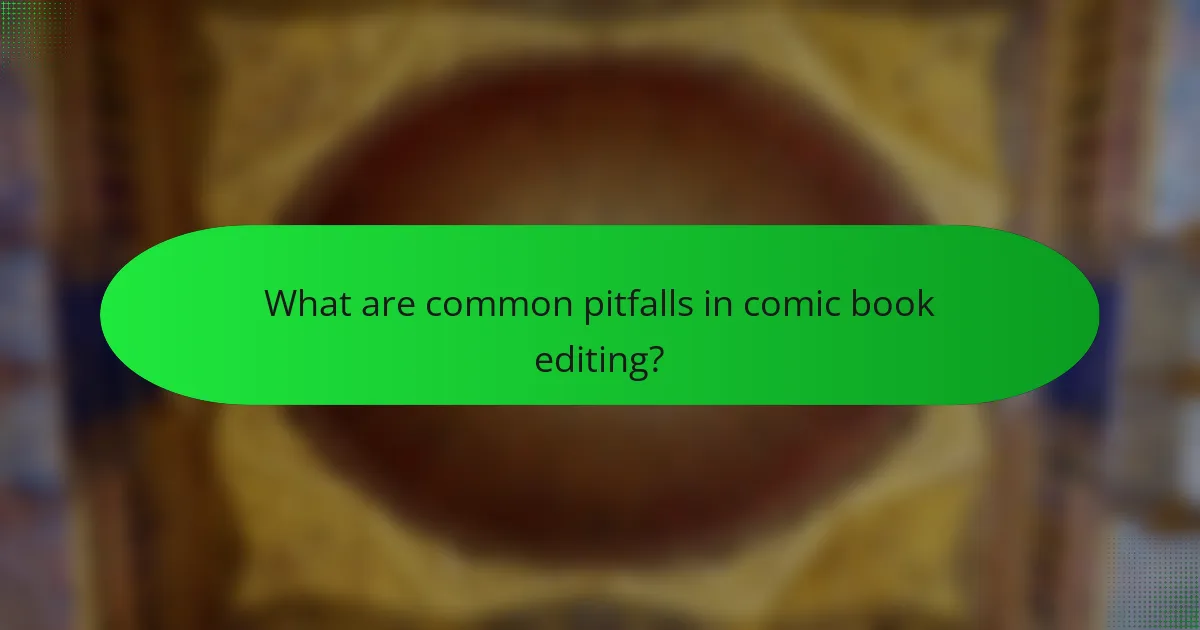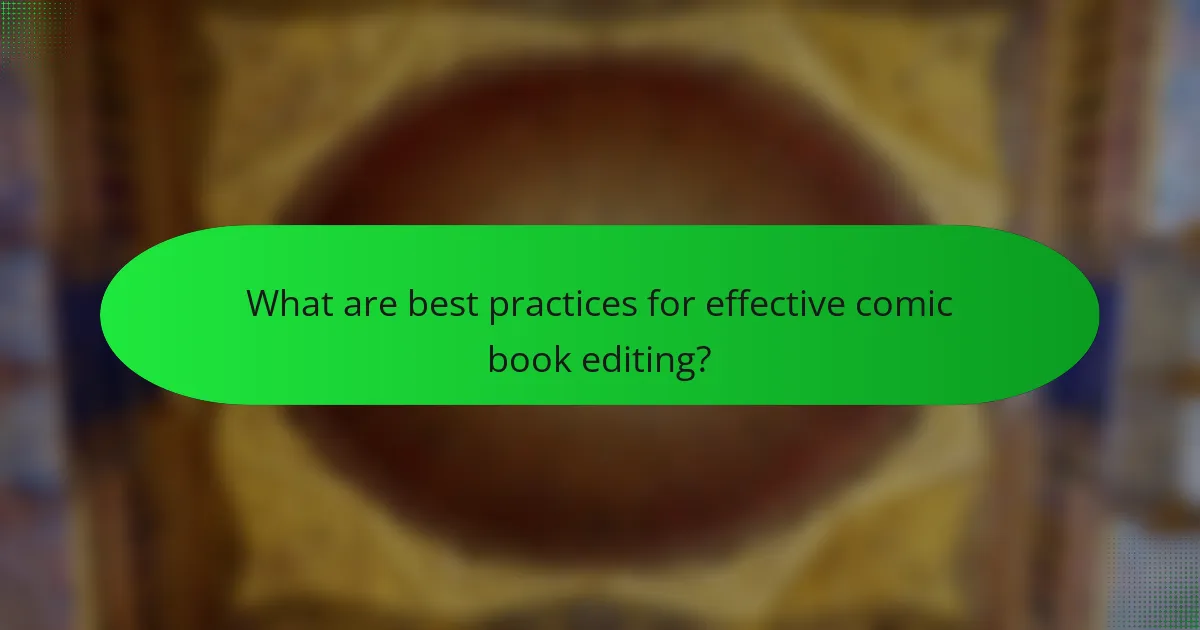The article focuses on the process of comic book editing, detailing essential steps that ensure quality and coherence in the final product. Key steps include reviewing the script and artwork, checking for character design consistency, and verifying grammar and punctuation. It highlights common pitfalls such as overlooking continuity errors, inadequate communication, and neglecting pacing issues, which can hinder reader engagement. Best practices for effective editing are also discussed, emphasizing the importance of collaboration with the creative team and understanding the target audience to enhance the overall narrative and visual storytelling.

What is the Process of Comic Book Editing?
The process of comic book editing involves several key steps. First, the editor reviews the script and artwork. This ensures the story flows logically and the art aligns with the narrative. Next, the editor checks for consistency in character design and plot points. They also verify grammar, spelling, and punctuation throughout the dialogue. After this, the editor provides feedback to the writer and artist for revisions. Once changes are made, a final review is conducted. This process ensures the comic book is polished and ready for publication. Each step is crucial for maintaining quality and coherence in the final product.
How does comic book editing differ from other forms of editing?
Comic book editing differs from other forms of editing primarily due to its unique integration of visual and textual elements. In comic book editing, editors must ensure that the artwork and narrative complement each other effectively. This requires a keen understanding of pacing, as visual storytelling relies heavily on the arrangement of panels. Editors also focus on dialogue placement within speech bubbles to maintain clarity and flow. Unlike traditional prose editing, comic book editors often collaborate closely with artists to achieve the desired visual impact. Additionally, comic book scripts require specific formatting that accommodates both dialogue and visual cues. This complexity makes comic book editing a specialized field within the broader editing landscape.
What are the unique aspects of comic book storytelling?
Comic book storytelling uniquely combines visual art and narrative text. This integration allows for a dynamic pacing that differs from traditional prose. The use of sequential art conveys complex emotions and actions efficiently. Dialogue is often concise, enhancing the visual storytelling. Panels create a rhythm that guides reader engagement. Visual symbolism adds layers of meaning to the narrative. The interplay of text and imagery allows for multiple interpretations. Iconic characters and their development are central to the genre’s appeal.
How does visual art influence the editing process?
Visual art significantly influences the editing process in comic book creation. The visual elements set the tone and pacing of the narrative. Editors assess artwork for clarity and coherence with the storyline. Art can dictate the flow of panels, impacting how the story is perceived. Additionally, visual consistency is crucial for maintaining reader engagement. Editors often suggest changes to enhance visual storytelling. This collaboration between artists and editors ensures a cohesive final product. Research shows that effective visual communication can improve reader comprehension by 70%.
What are the key steps involved in comic book editing?
The key steps involved in comic book editing include script review, art review, lettering review, and final proofreading. Script review ensures the story flows well and aligns with the visual elements. Art review checks for consistency in character design and scene layout. Lettering review focuses on dialogue clarity and placement within panels. Final proofreading catches any remaining errors in text or visuals. Each step is crucial for maintaining quality and coherence in the comic book.
What is the role of the editor in the initial stages?
The role of the editor in the initial stages is to oversee the development of the comic book’s concept and structure. Editors collaborate with writers and artists to refine storylines and characters. They ensure that the narrative aligns with the intended audience and market trends. Editors also provide feedback on scripts and artwork, focusing on pacing and clarity. They help establish a cohesive vision for the project. By facilitating communication among team members, editors enhance productivity. Their involvement sets the groundwork for a successful comic book. This process is crucial for identifying potential issues early on.
How is the script reviewed and revised during editing?
The script is reviewed and revised through a structured editing process. Editors read the script for clarity and coherence. They check for consistency in character development and plot progression. Feedback is provided to the writer for necessary changes. Revisions are made to enhance dialogue and pacing. The script undergoes multiple rounds of editing to refine the narrative. Each round focuses on specific elements, such as structure or character arcs. This iterative process ensures a polished final product.
What aspects of artwork are evaluated during the editing process?
The aspects of artwork evaluated during the editing process include composition, color, and clarity. Composition refers to the arrangement of elements within the artwork. Editors assess whether the layout effectively communicates the story. Color evaluation focuses on the use of color harmony and contrast. Clarity is about ensuring that details are visually distinct. Additionally, editors check for consistency in style across panels. They also consider the emotional impact of the artwork. Each of these aspects contributes to the overall effectiveness of the comic book.
Why is feedback important in comic book editing?
Feedback is important in comic book editing because it enhances the quality of the final product. It provides insights into narrative clarity and character development. Editors can identify inconsistencies in plot and pacing through feedback. Constructive criticism helps creators refine their artwork and dialogue. Additionally, feedback fosters collaboration among writers, artists, and editors. It ensures that the comic resonates with its target audience. Studies show that iterative feedback loops improve storytelling effectiveness. Ultimately, feedback is a crucial component of the editing process that leads to a polished, engaging comic book.
How can constructive criticism enhance the final product?
Constructive criticism enhances the final product by providing valuable feedback that identifies strengths and weaknesses. It allows creators to see their work from different perspectives. This feedback can lead to improvements in storytelling, art, and overall coherence. For example, a study in the Journal of Creative Behavior found that peer feedback significantly increased the quality of creative projects. By incorporating specific suggestions, creators can refine their work. This iterative process leads to a more polished and engaging final product. Ultimately, constructive criticism fosters collaboration and innovation in comic book editing.
What methods can be used to gather feedback effectively?
Surveys and questionnaires are effective methods to gather feedback. They can be distributed online or in print. This approach allows for quantitative data collection. Interviews provide qualitative insights through direct conversation. Focus groups encourage discussion and diverse perspectives. Observation of user interactions can reveal unspoken feedback. Feedback forms after events capture immediate reactions. Social media polls engage a wider audience quickly. Each method can be tailored to the specific context of comic book editing.

What are common pitfalls in comic book editing?
Common pitfalls in comic book editing include overlooking continuity errors. These errors can disrupt the narrative flow and confuse readers. Another pitfall is inadequate communication with the creative team. Poor communication can lead to misunderstandings about the story or character development. Additionally, neglecting pacing issues can result in a rushed or dragged-out story. This affects reader engagement significantly. Failing to provide constructive feedback is also common. Without clear guidance, creators may struggle to improve their work. Lastly, not considering the target audience can lead to misaligned content. Understanding the audience ensures the comic resonates effectively.
What mistakes do editors frequently make?
Editors frequently make mistakes such as overlooking typos and grammatical errors. This can lead to a lack of professionalism in the final product. Additionally, they may fail to maintain consistency in style and tone. This inconsistency can confuse readers and disrupt the narrative flow. Another common mistake is not providing clear feedback to writers. Vague feedback can hinder a writer’s ability to improve their work. Editors also sometimes neglect to check for factual accuracy. This oversight can result in misinformation being published. Lastly, they may rush the editing process, leading to incomplete revisions. A rushed process often compromises the quality of the comic book.
How can overlooking pacing affect the narrative?
Overlooking pacing can disrupt the narrative flow in comic books. Pacing controls the rhythm of storytelling. If pacing is too fast, readers may miss important character development. This can lead to confusion about plot points. Conversely, if pacing is too slow, readers may lose interest. Proper pacing maintains engagement and emotional impact. Research shows that effective pacing enhances reader comprehension and enjoyment. For example, a study by McCloud emphasizes the importance of timing in comic storytelling. Thus, neglecting pacing can negatively affect reader experience and narrative clarity.
What are the consequences of inconsistent character development?
Inconsistent character development leads to a lack of credibility and engagement in storytelling. Characters may appear unrealistic or contradictory to their established traits. This inconsistency can confuse readers and disrupt the narrative flow. It may also result in diminished emotional investment from the audience. When characters do not evolve logically, it undermines plot progression. Furthermore, it can lead to negative reviews and reduced readership. Research indicates that well-developed characters significantly enhance reader satisfaction and retention. Inconsistent character arcs can detract from these positive outcomes.
How can these pitfalls be avoided?
To avoid pitfalls in comic book editing, implement a structured review process. Establish clear guidelines for each stage of editing, including script, art, and lettering reviews. Regular communication between writers, artists, and editors helps clarify expectations. Utilize checklists to ensure all elements meet quality standards. Schedule multiple rounds of feedback to catch errors early. Encourage a collaborative environment for constructive criticism. Document decisions made during the editing process for future reference. These practices enhance the overall quality and coherence of the comic book.
What strategies can editors implement to maintain narrative flow?
Editors can maintain narrative flow by implementing several key strategies. First, they should ensure consistent character development throughout the story. This helps readers connect with the characters and follow their journeys smoothly. Second, editors must check for logical progression in the plot. Each event should lead naturally to the next, avoiding abrupt shifts that can confuse readers. Third, they should focus on pacing. Balancing action and dialogue keeps the story engaging while allowing moments for reflection. Fourth, editors can utilize transitions effectively. Clear transitions between scenes or chapters guide readers through the narrative seamlessly. Fifth, they should encourage thematic continuity. Repeating key themes reinforces the story’s message and enhances coherence. Lastly, editors must be vigilant for inconsistencies in tone and style. A unified voice throughout the comic maintains immersion and strengthens the overall narrative. These strategies collectively contribute to a more fluid and engaging narrative experience for readers.
How important is collaboration with writers and artists?
Collaboration with writers and artists is crucial in the comic book editing process. Effective collaboration enhances storytelling and visual representation. Writers provide narrative structure and dialogue, while artists bring the story to life through visuals. This synergy results in a cohesive and engaging comic book. Research shows that projects with strong collaboration often yield higher quality outcomes. For instance, a study by the University of Southern California found that collaborative teams produce more innovative work. Therefore, fostering collaboration is essential for successful comic book creation.

What are best practices for effective comic book editing?
Effective comic book editing requires a clear understanding of the narrative structure and visual storytelling. Editors should ensure that the story flows logically from panel to panel. Consistency in character design and dialogue is crucial for maintaining reader engagement. Editors must also check for grammatical errors and typos, as these can distract readers. Collaboration with writers and artists is essential to refine the overall vision. Regular communication helps in addressing issues promptly. Utilizing feedback from beta readers can provide valuable insights. Finally, staying updated with industry trends enhances the editor’s effectiveness.
What techniques can improve the editing process?
Utilizing techniques such as checklists, peer reviews, and digital tools can significantly improve the editing process. Checklists help ensure that all necessary elements are addressed during editing. Peer reviews provide fresh perspectives and catch errors that the original editor may have missed. Digital tools, like grammar checkers and style guides, streamline the editing workflow. Research shows that structured editing techniques result in higher quality outputs. For instance, a study by the American Psychological Association found that peer-reviewed work is often more reliable than unreviewed content.
How can an editor ensure clarity in dialogue and captions?
An editor can ensure clarity in dialogue and captions by focusing on concise language. Clear dialogue should reflect each character’s voice and personality. Captions must provide context without overwhelming the reader. Consistent formatting helps maintain clarity throughout the comic. Editors should eliminate unnecessary words to enhance readability. They should also check for grammatical accuracy to avoid confusion. Using visual cues can aid in understanding dialogue and captions. Regular feedback from beta readers can highlight areas needing improvement. These practices collectively enhance the overall clarity of the comic’s narrative.
What role does organization play in the editing workflow?
Organization is crucial in the editing workflow as it streamlines the process and enhances efficiency. A well-structured workflow allows editors to track changes, manage deadlines, and coordinate with creators effectively. It ensures that all materials are easily accessible, reducing time spent searching for files. Organized systems help maintain consistency across the comic book, ensuring that styles and narratives align. Additionally, clear organization minimizes the risk of overlooking important revisions or feedback. Research indicates that organized editing processes can improve overall project outcomes, leading to higher quality publications.
How can editors maintain a consistent tone throughout the comic?
Editors can maintain a consistent tone throughout the comic by establishing clear guidelines for voice and style. These guidelines should include specific language, character dialogue, and narrative pacing. Regular communication with writers and artists is essential to ensure everyone understands these guidelines. Editors should review scripts and artwork frequently to provide feedback on tone consistency. Utilizing reference materials, such as tone charts or style guides, can help reinforce the desired tone. Additionally, holding collaborative meetings can align the creative team on tone expectations. Consistency checks during the editing process help identify any deviations from the established tone. By implementing these strategies, editors can effectively maintain a cohesive tone throughout the comic.
What tools can assist in ensuring tone consistency?
Style guides assist in ensuring tone consistency. They provide clear guidelines on language, tone, and style. Tools like Grammarly and Hemingway Editor help maintain tone through real-time feedback. These tools analyze writing for clarity and consistency. Additionally, collaborative platforms like Google Docs allow multiple editors to review and comment. This fosters a unified voice across the comic book. Regular team meetings can reinforce tone guidelines. Consistent communication ensures everyone is aligned on the desired tone.
How can editors align the visual style with the written narrative?
Editors can align the visual style with the written narrative by ensuring consistency in tone and imagery. They should analyze the script to identify key themes and emotions. This analysis informs the choice of colors, fonts, and illustrations. Visual elements must reflect the narrative’s mood, enhancing storytelling. For instance, darker tones can evoke tension, while lighter colors may suggest humor. Collaboration between writers and artists is essential for cohesive vision. Regular feedback sessions help maintain alignment throughout the editing process. Ultimately, a unified approach strengthens the overall impact of the comic.
What practical tips can enhance the comic book editing experience?
To enhance the comic book editing experience, establish a clear workflow. A defined process streamlines tasks and improves efficiency. Utilize software tools designed for comic editing. Programs like Adobe InDesign or Clip Studio Paint offer specific features for comic layout. Create a style guide to maintain consistency in artwork and dialogue. This ensures a cohesive visual and narrative style throughout the comic. Regularly hold feedback sessions with the creative team. Collaborative input can identify areas for improvement early in the editing process. Implement a checklist for common editing pitfalls. This can include grammar checks, panel flow, and pacing issues. Prioritize clear communication with artists and writers. Open dialogue fosters a better understanding of the creative vision. Lastly, take breaks to maintain perspective. Stepping away can lead to fresh insights upon return.
The main entity of this article is comic book editing, which encompasses the systematic process of reviewing scripts and artwork to ensure narrative coherence and visual consistency. Key steps in the editing process include script review, art evaluation, lettering checks, and final proofreading, all aimed at producing a polished comic book. The article also highlights common pitfalls such as continuity errors and inadequate communication, as well as best practices for effective editing that enhance collaboration among writers and artists. Additionally, it discusses the significance of feedback and the role of organization and tone consistency in achieving a successful final product.